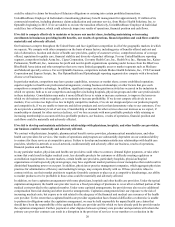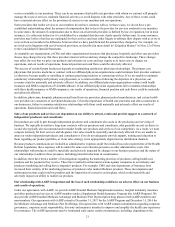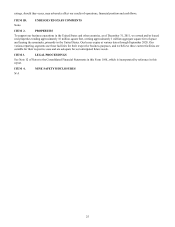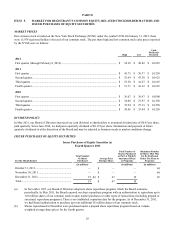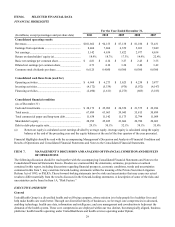United Healthcare 2011 Annual Report Download - page 26
Download and view the complete annual report
Please find page 26 of the 2011 United Healthcare annual report below. You can navigate through the pages in the report by either clicking on the pages listed below, or by using the keyword search tool below to find specific information within the annual report.24
defects or may encounter unexpected complications during installation or when used with other technologies utilized by the
customer. Connectivity among competing technologies is becoming increasingly important in the health care industry. A failure
of our technology products to operate as intended and in a seamless fashion with other products could materially and adversely
affect our results of operations, financial position and cash flows.
In addition, an uncertain and rapidly evolving federal, state, international and industry legislative and regulatory framework
related to the health information technology market may make it difficult to achieve and maintain compliance and could
materially and adversely affect the configuration of our information systems and platforms, and our ability to compete in this
market.
If we are not able to protect our proprietary rights to our databases and related products, our ability to market our
knowledge and information-related businesses could be hindered and our results of operations, financial position and
cash flows could be materially and adversely affected.
We rely on our agreements with customers, confidentiality agreements with employees, and our trademarks, trade secrets,
copyrights and patents to protect our proprietary rights. These legal protections and precautions may not prevent
misappropriation of our proprietary information. In addition, substantial litigation regarding intellectual property rights exists in
the software industry, and we expect software products to be increasingly subject to third-party infringement claims as the
number of products and competitors in this industry segment grows. Such litigation and misappropriation of our proprietary
information could hinder our ability to market and sell products and services and our results of operations, financial position
and cash flows could be materially and adversely affected.
Our ability to obtain funds from some of our subsidiaries is restricted and if we are unable to obtain sufficient funds
from our subsidiaries to fund our obligations, our results of operations and financial position could be materially and
adversely affected.
Because we operate as a holding company, we are dependent upon dividends and administrative expense reimbursements from
some of our subsidiaries to fund our obligations. Many of these subsidiaries are regulated by states' departments of insurance.
We are also required by law or regulation to maintain specific prescribed minimum amounts of capital in these subsidiaries.
The levels of capitalization required depend primarily upon the volume of premium revenues generated by the applicable
subsidiary. A significant increase in premium volume will require additional capitalization from us. In most states, we are
required to seek prior approval by these state regulatory authorities before we transfer money or pay dividends from these
subsidiaries that exceed specified amounts. An inability of our regulated subsidiaries to pay dividends to their parent companies
in the desired amounts or at the time of our choosing could adversely affect our ability to reinvest in our business through
capital expenditures or business acquisitions, as well as our ability to maintain our corporate quarterly dividend payment cycle,
repurchase shares of our common stock and repay our debt. If we are unable to obtain sufficient funds from our subsidiaries to
fund our obligations, our results of operations and financial position could be materially and adversely affected.
Any failure by us to manage and complete acquisitions and other significant strategic transactions successfully could
materially and adversely affect our business, prospects, results of operations, financial position and cash flows.
As part of our business strategy, we frequently engage in discussions with third parties regarding possible investments,
acquisitions, divestitures, strategic alliances, joint ventures, and outsourcing transactions and often enter into agreements
relating to such transactions. If we fail to identify and complete successfully transactions that further our strategic objectives,
we may be required to expend resources to develop products and technology internally, we may be at a competitive
disadvantage or we may be adversely affected by negative market perceptions, any of which may have a material adverse effect
on our results of operations, financial position or cash flows. For acquisitions, success is also dependent upon efficiently
integrating the acquired business into our existing operations. We are required to integrate these businesses into our internal
control environment, which may present challenges that are different than those presented by organic growth and that may be
difficult to manage. If we are unable to successfully integrate and grow these acquisitions and to realize contemplated revenue
synergies and cost savings, our business, prospects, results of operations, financial position and cash flows could be materially
and adversely affected.
Downgrades in our credit ratings, should they occur, may adversely affect our business, financial condition and results
of operations.
Claims paying ability, financial strength, and credit ratings by nationally recognized statistical rating organizations are
important factors in establishing the competitive position of insurance companies. Ratings information is broadly disseminated
and generally used throughout the industry. We believe our claims paying ability and financial strength ratings are important
factors in marketing our products to certain of our customers. Our credit ratings impact both the cost and availability of future
borrowings. Each of the credit rating agencies reviews its ratings periodically and there can be no assurance that current credit
ratings will be maintained in the future. Our ratings reflect each credit rating agency's opinion of our financial strength,
operating performance and ability to meet our debt obligations or obligations to policyholders. Downgrades in our credit








